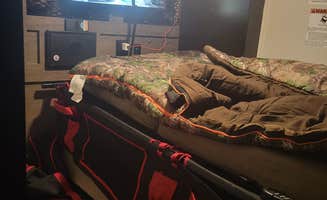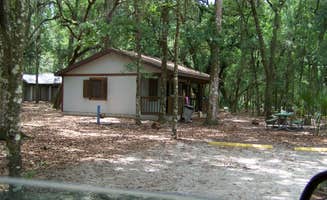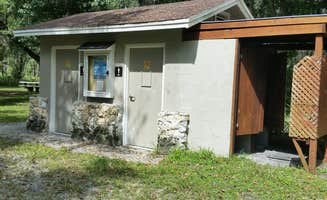Fort De Soto Campground offers waterfront camping near Tampa Bay with sites available for both RVs and tents. The campground features three separate loops with electric and water hookups, and many sites positioned directly on the water. Visitors can access beaches, bike trails, and historic sites within the 1,136-acre county park. Campground reservations open six months in advance, with a limited number of weekend sites released each Friday at 7am.
What to do
Explore the wildlife habitat: Fort De Soto Campground provides excellent wildlife viewing opportunities throughout its extensive grounds. "Great bike trails. Lots of wildlife - we saw raccoons, dolphin, manatee, tons of birds!" notes Brennan H. The park's diverse ecosystem supports numerous species visible from the campground and along trails.
Visit historic sites: The fort itself offers educational value for glampers interested in local history. "The historic fort, scenic beaches, trails for hiking or biking, etc made for a great visit," shares Brennan H. about Fort De Soto Campground. The military installation provides context about the area's strategic importance.
Kayak through mangroves: E.G. Simmons Regional Park offers water access ideal for paddling adventures. "We were in site 55 of the East CG which was right on the water where we launched our kayaks to paddle the canals amongst the Mangroves," reports Bran P. about their experience at E.G. Simmons Regional Park. The canals provide protected waterways for exploration.
What campers like
Spacious, private sites: Many campgrounds provide good separation between camping areas. "Our site was nice and deep, with a weird little island (former tree/stump) in the middle. This actually made us divide the tent area up into two sides, which worked out well," explains Joe R. about Fort De Soto Campground. Site selection significantly impacts privacy levels.
Natural vegetation buffers: The native plant life helps maintain a wilderness feel despite proximity to urban areas. "They did a great job at keeping a lot of natural growth to maintain privacy and a true tropical feel," notes Joe R. This landscaping approach preserves habitat while enhancing camper experience.
Clean facilities: Bathhouses and amenities receive regular maintenance. "Bath house is pretty central and literally across the road from our site. We had expected a much further walk based on the map, but it was just a 1 minute walk. They clean them daily," shares Joe R. At Jay B. Starkey Wilderness Park, visitors note "Starkey's Campground has everything you could want or need. Friendly staff, plenty of critters, and beautiful trails to walk."
What you should know
Insect preparation: No-see-ums and mosquitoes can be significant, especially at dusk. "You really cannot stay outside at dusk. Citronella torches, spray, fans, Avon skin so soft...none of these work for the no-see-ums," warns Christy C. about E.G. Simmons Regional Park. Timing outdoor activities for morning and midday helps avoid peak insect activity.
Booking requirements: Reservation systems vary between parks. At Fort De Soto, "they do start booking 6 months out and open up 10% of the sites for the weekend each friday at 7am if you want to try and get lucky," advises Joe R. Planning ahead is essential during peak season.
Park restrictions: Some glamping areas have specific limitations. At Terry Tomalin Campground, "you can only tent and you are not allowed to smoke anything, vape anything, drink anything alcoholic," reports Kevin W. Each park maintains different rules regarding pets, alcohol, and acceptable camping equipment.
Tips for camping with families
Playground access: Several parks offer recreational areas specifically designed for children. At E.G. Simmons Regional Park, Judy B. reports, "There is a playground for children." Fort De Soto also provides "a playground with good swings and also a sturdy playground that offered plenty of opportunity for my four year old to blow off some steam."
Educational opportunities: Wildlife viewing becomes a learning experience. At Hillsborough River State Park Campground, "Nice trails, great river canoeing. Close to Tampa and Busch Gardens," notes Billie S. The environmental education components supplement traditional recreation.
Safety considerations: Wildlife awareness remains important. At Myakka River State Park, a camper warns, "Went to drain the tanks yesterday morning and a large sounding gator started to growl territorially at me. So heads up with your pets please." Wildlife encounters require appropriate caution and supervision.
Tips from RVers
Site surface variations: RV pads differ significantly between parks. At Myakka River State Park, a visitor notes, "I'm staying in the Palmetto Ridge loop which is the only paved loop & I think the only one w/sewer. The Big Flats & Old Prairie loops are gravel road, tight, no privacy & very small sites like for popups, vans or small campers."
Hookup availability: Utilities vary by campground and specific loop. "Gravel sites but pretty level. My site was 50 amp. Not sure how many are," explains Amanda W. about Myakka River State Park. Fort De Soto provides "Electric and water. 2 dump sites on property," according to David G.
Campground navigation: Some RV parks have challenging layouts. At Horseshoe Cove RV Resort, a reviewer advises, "I am in the pull thru sites which are a little tight and can be challenging to park on in big rigs. Roads are narrow with lots of turns."





